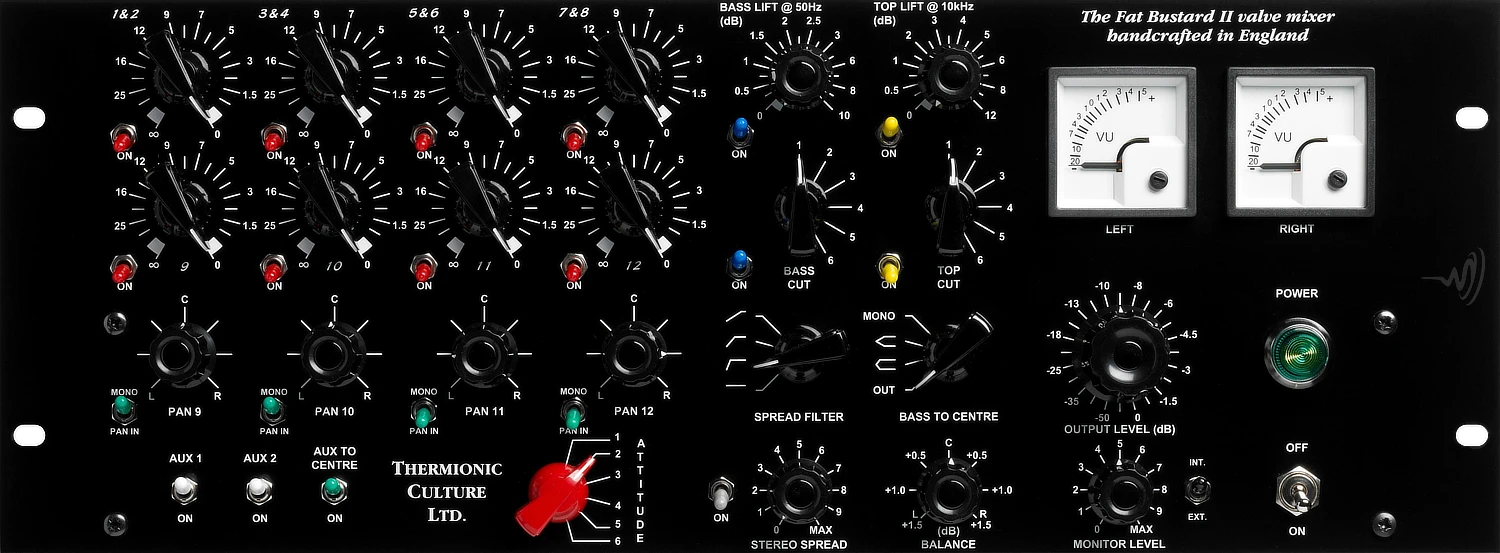The Fat Bustard is unique in it’s exceptional sound quality and also the extra degree of control and processing it offers over the stereo mix output. The Thermionic Culture Fat Bustard II version is now the standard production model, and it has been upgraded to include a monitor output with level control.
Much of the attractive sound provided by the Thermionic Culture Fat Bustard II is down to the choice of valves used. The summing is done by a pair of 5965 valves and the output stage uses a pair of 6SN7 valves. This combination provides a very large amount of headroom and a unique smooth sounding response. It’s also worth noting that the unit has “semi-floating” inputs and unbalanced outputs. This was a decision made at the design stage purely because the unit sounded better this way and performed excellently when connected for use in all situations.
The Thermionic Culture Fat Bustard II employs our unique “varislope” curves for top and bass lift. As the control is turned up, the peak frequency of the curve becomes more extreme so as to add heavier bass/brilliant top – without the hardness found in solid state EQs. The bass and top cuts provide a variety of options to tailor the sound – too many to list here. They are of course independent of the lifts. All controls affect both stereo channels equally.
The ‘Attitude’ control is the next to control the sound of the mix. This switched control gradually increases the amount of harmonic distortion in the stereo summing stage. It is relatively subtle (at least in the lower positions) to provide just the right amount of 2nd harmonic content for a stereo mix. At high positions the mix can be quite aggressive.
The stereo spread control allows the stereo to be widened by a continuous amount over a selectable frequency range. The ‘Spread filter’ control allows the frequency above which widening occurs to be selected from full band widening to only widening above 5KHz. Again, this control can be used to vary the tone of the stereo mix as well as the stereo width. Along with stereo widening at higher frequencies.
The ‘Bass to Centre’ control allows bass frequencies in the stereo mix to be summed to mono for 2 different low frequency ranges, plus there is a setting for all frequencies to mono. A Stereo ‘balance’ control and rotary 31 position ELMA switch for ‘Output level’ give full control over output levels.
The ‘Monitor level’ control, int/ext switch and extra outputs provide a useful way to connect and control monitors to the Thermionic Culture Fat Bustard II. Especially useful when the Fat Bustard is the only mixer being used. If this is not a requirement then the int/ext switch in conjunction with the monitor outputs can be used to provide an insert in/out switch.
Thermionic Culture Fat Bustard II Features
- All valve 14 channel passive summing mixer with many extras!
- Pan controls on 4 channels.
- Unique Varislope Top and Bass lifts plus filters.
- ‘Attitude’ control to add harmonics.
- Stereo width controls / Bass to centre and mono.
- Precision ELMA switch to control main level (fadeable).
- Monitor outputs with level control and switching.
- Hand wired with point-to-point wiring throughout.
- Exceptional sound quality- very low distortion except when required and massive ‘headroom’.
- Frequency response extends from below audio range to well above.



